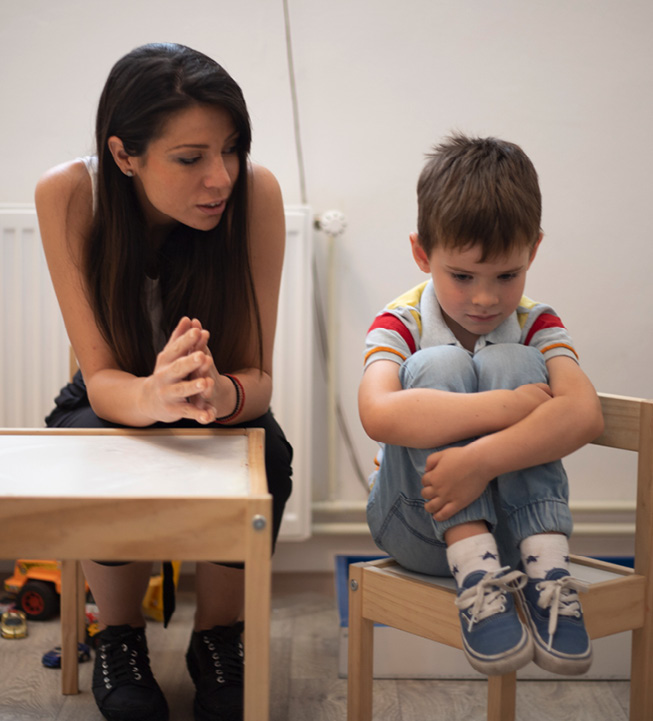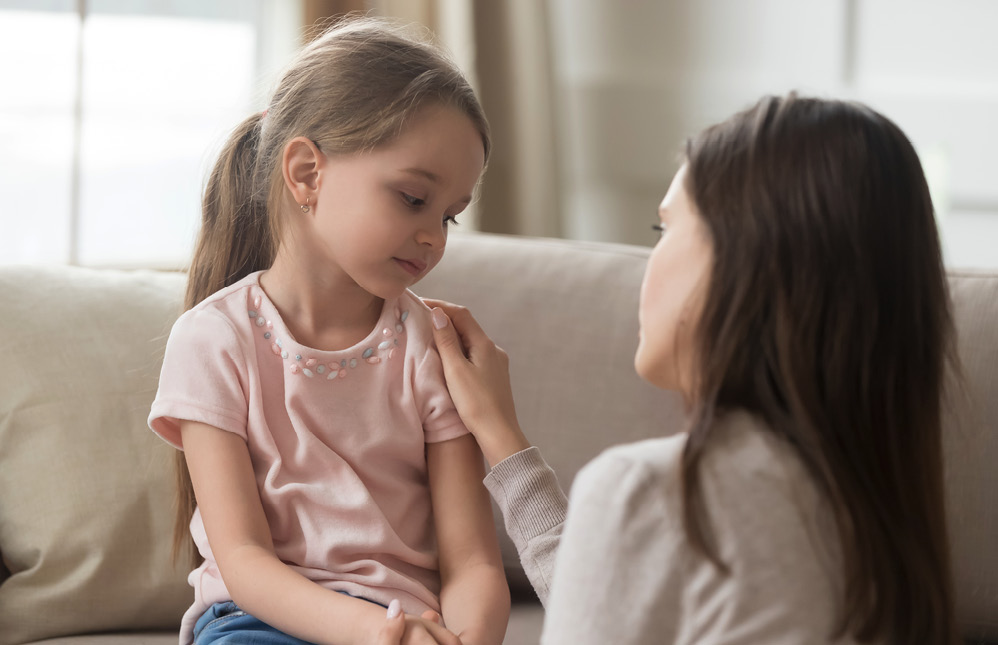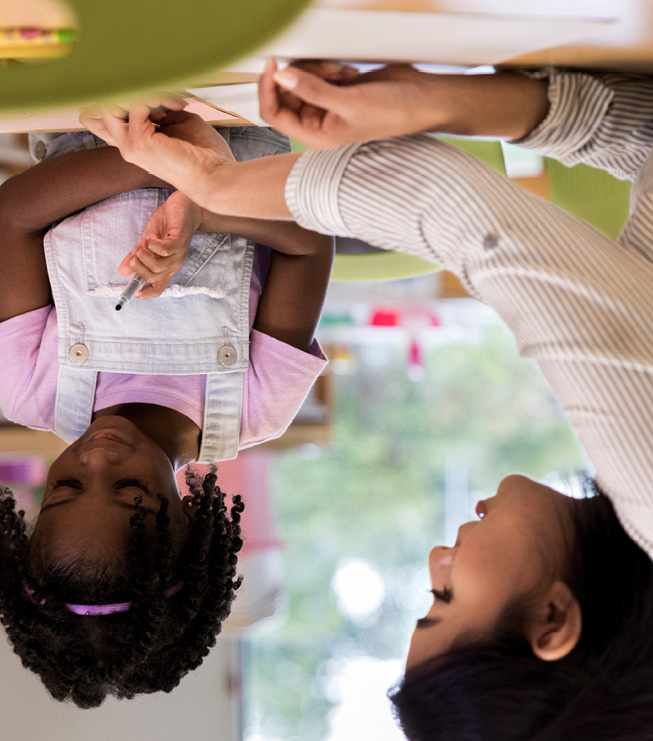Supporting Young Children after Crisis Events

You are here
For presentations on and additional resources for talking to children about the COVID-19 pandemic, visit the National Center for School Crisis and Bereavement’s resource page. David J. Schonfeld (an author of this article) also presented a webinar for NAEYC titled "Talking to and Supporting Children and Ourselves During the Pandemic."
During the course of young children’s development, they are exposed to a variety of potentially stressful events that challenge their sense of security and stability, like with the wildfires in Sofia's community in the opening vignette. Not all stressful events are harmful, though, and many challenging experiences can help a child develop or strengthen coping strategies. For example, a child being left with a warm, reliable caregiver in the evening can help them develop the capacity to trust other caregivers.
Young children are particularly vulnerable to the effects of community disasters and other crises and traumatic events.
Stressful and disruptive events can range from minor family crises (cancellation of a family vacation) to major family crises (parental divorce) to community disasters (widespread flooding) and international crises (pandemics). Young children’s perceptions of the degree to which a crisis threatens or undermines their relationships with parents or guardians and other important caregivers—including early childhood educators—often determine the amount of stress children experience. Events in which a child’s or a family member’s life is threatened may be particularly traumatic.
Young children are particularly vulnerable to the effects of community disasters and other crises and traumatic events. This is because of their lack of experiences, skills, and resources that would otherwise enable them to independently meet their developmental, social and emotional, mental, and behavioral health needs. Crises can also potentially have short- and long-term effects on children’s psychological functioning, emotional adjustment, health, and developmental trajectories, and may even have implications for their health and their social and psychological functioning in adulthood. As a group, children are resilient, but they are still among those most at risk of psychological trauma and behavioral difficulties after a crisis.
Common adjustment reactions of young children
In the aftermath of a crisis, most children may demonstrate no observable reactions, even if they are, in fact, having adjustment difficulties. What may further confuse adults is that children’s reactions may be nonspecific (e.g., children may become less flexible about schedule changes or demand more attention), and adults may not appreciate the behaviors’ connections to the crisis event.
Children often do not have a full understanding of their feelings or the ability to communicate in words new reactions they have not felt before. This may mislead parents, early childhood educators, and other primary caregivers to believe that the children have not been affected by the event. They tend to underestimate the level of children’s distress and overestimate children’s resilience, especially if the adults rely only on observations of children’s behaviors.
Adults who are reacting to the same event may also be less able to notice the subtlety of children’s emotional expressions because they are focusing on their own adjustment. In addition, it is well recognized that children’s reactions to a crisis are often related to how well the adults in their personal lives are coping. Adults who themselves are having emotional difficulty navigating the crisis may make children feel less safe and secure and may serve as negative models of emotional regulation.
Early childhood educators can provide guidance and advice to families about how to identify and address the most common adjustment reactions that can be anticipated among children after a crisis event. Children’s anticipated reactions include the following:
- Sleep problems—Difficulty falling or staying asleep; nightmares; difficulty waking up in the morning, waking frequently during the night, and other sleep disruptions. Following a crisis event, children often develop new sleep associations that help them feel more secure (like sleeping in their parents’ bedroom) but which may be difficult to later modify.
- Eating problems—Loss of appetite or increased eating.
- Sadness or depression—Reluctance to engage in previously enjoyed activities or not wanting to be with peers or adults.
- Anxiety, worries, or fears—Concern that the scary, dangerous, or frightening event will happen again, causing a high level of watchfulness and suspicion. There may also be an increase in seemingly unrelated fears (e.g., becoming more afraid of the dark even if a natural disaster happened during daylight). Children may develop separation anxiety, becoming very fearful when not in the presence of their parents or other caregivers and showing new or exaggerated distress when separating at morning drop-off.
- Difficulties in concentration—Decreased ability to maintain attention and focus or increased difficulty in learning or in applying their learning.
- Somatization—Presentation of nonspecific complaints of discomfort, pain (such as stomachaches or headaches), fatigue, or other physical symptoms suggesting a physical condition, especially among children with adjustment difficulties and children who have difficulty expressing their emotional concerns.
- Regression—Clinginess and whininess with adults or engagement in behaviors (bed wetting, disobeying rules) children have already mastered.
- Post-traumatic stress reactions are frequently observed immediately after and for weeks following traumatic events and are described in more detail later on in this article.
How educators can support young children after crises
After a large-scale natural disaster that widely impacted the community, the early education director for the school district feels unsure about how to support the children in her care. In a meeting with the director of the National Center for School Crisis and Bereavement (who is consulting with educational leadership), she comments, “We don’t know what to do to help these children recover after an event such as this. All we can do is hug them, show them we care about them, provide a safe and secure environment with appropriate structure and support, encourage them to talk and otherwise express their concerns, and provide reassurance when able. But we desperately need training on how to promote their recovery.”
The director, Dr. Schonfeld, explains that what the educators already know to do—based on the way they offer support every day to young children in response to a wide range of personal and family stresses—is exactly what these children need to help them recover from the traumatic effects of the natural disaster.
Early childhood educators play a critical role and are likely to provide the majority of support for many young children impacted by a crisis event. Whenever possible, as soon as it is safe and feasible, it is helpful to have children return to their regular early education site to be cared for by familiar caregivers. In some situations, after major natural disasters, federal funds are made available for emergency child care, but this is restricted to public child care programs. For-profit providers of early education may not qualify for these federal funds, and this may encourage families to use unfamiliar providers at a time when continuity of care is most critical for children.
After a large-scale natural disaster, early childhood educators may be asked to provide supervision, such as in emergency shelters, while parents or guardians attend to other important tasks, such as restoring a safe home environment. Cleaning and rendering the home environment safe (clearing water, debris) is best done when children are supervised in a safe, alternative location and are not distracting parents or caregivers.
The effects of a disaster on individual children vary based on a number of factors, including
- Whether the stressor is a one-time or recurrent event
- The nature of the event (e.g., whether a crisis is caused by human factors or by nature) and the amount of associated death, destruction, or suspension of needed resources and disruption of support systems (e.g., school closing) that children depend on
- The degree to which children and their families are personally involved and impacted (e.g., if their homes or possessions were destroyed)
- The duration of time before children’s daily environment, and that of the overall community, returns to a safe, predictable, and comfortable routine
- The coping abilities of the children’s caregivers
- Children’s preexisting mental health, developmental levels, and baselin resiliency and coping skills
- The nature of the secondary stressors and of the losses that follow the crisis event (for example, after Hurricane Maria, more than half of children lost someone close to them due to family members’ or friends’ permanent relocation from Puerto Rico) (Orengo-Aguayo et al. 2019)
Early childhood educators can ask families about what their children were exposed to as a result of the crisis, what the children understand about what has happened to their family and community, and whether there are ongoing stressors that may complicate recovery, as well as asking additional questions that explore and identify possible risk and potentially protective factors. One particularly important stressor for young children is separation from parents or other important caregivers as a result of the crisis, even if only temporary.
It has been shown that children who must separate from parents or important caregivers in order to avoid risk of physical harm may have a greater number or degree of adjustment difficulties than those who remain in situations of possible harm but with their parents and caregivers. For example, in a study of young children evacuated from London during aerial bombing in World War II, young children who separated from their mothers in order to relocate to safer communities were often more likely to later have persistent emotional and behavioral problems—such as anxiety and fears—than those children who remained with their mothers in London during the bombing (Carey-Trefzer 1949).
After crisis events, it should be a high priority to reunite separated children with their families or other trusted caregivers as quickly as possible.
If separation is required, such as when one parent has to stay in the home temporarily while another parent evacuates with the children, it is critical to explain to children the reason for the temporary separation, how long they should anticipate the separation to last, and the plans for reunification (Scheeringa & Zeanah 2008). Phone or video contact with the absent parent may help ease children’s concerns about the parent’s well-being. After crisis events, it should be a high priority to reunite separated children with their families or other trusted caregivers as quickly as possible.
Post-traumatic stress and young children
Post-traumatic stress disorder (PTSD) may occur in a child if the child or a close family member was exposed to actual or threatened death, serious injury, or sexual violence, and the following reactions persist for at least one month after such an event:
- Intrusive and unwanted memories, dreams, and feelings. These may include the child’s feeling that the traumatic event is occurring again and the child’s loss of awareness (dissociation) of where they are. Play activities may include themes associated with the event, and some play may involve reenactment of the traumatic experience in association with agitation and distress. This type of play should prompt referral to a mental health provider for consideration of post-traumatic stress disorder.
- Avoidance of memories, thoughts, feelings, and external reminders (people, places, conversations, activities, situations) associated with the event.
- Negative thoughts and feelings (guilt, shame, anger), including loss of interest in pleasurable solitary or social activities and blaming of self and/or others.
- Increased arousal, resulting in sleep difficulties, conduct problems, difficulty staying on task, hypervigilance, and the appearance of being jumpy (easily startled) and cranky (irritable).
Secondary stress in young children following a crisis
After a crisis, a child’s trauma, loss, or adjustment difficulties from a previously experienced event may resurface or worsen, even if the issues do not relate directly to the current crisis. Many such problems may be a result of the family or community situation in which the child was living before the current crisis. For example, a child whose parent is not available because of legal, substance abuse, or mental health problems may feel vulnerable even before a new crisis occurs. As a result, this preexisting event or experience—the absence of the parent—may be the cause for what appears to be reactions to the current crisis.
 Because of their large-scale impact, disasters often also cause secondary losses and stressors that may become the primary concern for a particular child. For example, a child who has sleep problems months after a flood may be responding to marital discord or to parental distress related to financial concerns following the disaster. That is, the child is not solely struggling to cope with the flooding itself but with the resulting stressors in the home environment.
Because of their large-scale impact, disasters often also cause secondary losses and stressors that may become the primary concern for a particular child. For example, a child who has sleep problems months after a flood may be responding to marital discord or to parental distress related to financial concerns following the disaster. That is, the child is not solely struggling to cope with the flooding itself but with the resulting stressors in the home environment.
After a major natural disaster, it is common to see increased unemployment or underemployment, causing financial stress to families; a need for families to relocate, resulting in changes in children’s early childhood placements or in children’s peer groups; temporary living situations that are suboptimal or that cause interpersonal conflict; or depression, substance use, or marital conflict among parents. Child abuse and family violence have also been reported to increase after major disasters.
Given that these secondary losses and stressors may continue even for years after a major disaster, children’s adjustment difficulties may persist for a similarly extended time. It is therefore not surprising that following a major natural disaster, young children may continue to demonstrate adjustment reactions and behavioral changes for one or two years (or longer) after the disaster (Swenson et al. 1996; Fujiwara et al. 2014).
Bereavement when death has occurred
When children experience the death of someone close to them as a result of a crisis, their grief may be the primary reaction.
Parents, early childhood educators, and other caring adults are often reluctant to talk with children who are grieving, or even to raise the topic, out of a fear of causing further distress by “saying the wrong thing.” Their empathy for children may lead caregivers to assume that their questions or discussion with the children, rather than the death itself, has caused the children’s distress. Avoiding speaking with children about their feelings about a loss is rarely helpful and may only further isolate children at a time when they are most in need of support.
Early childhood educators can help grieving children’s caregivers understand the importance of inviting and answering questions. Teachers can provide caregivers with information to help guide children in understanding and adjusting to the loss and can help caregivers identify strategies for children for coping with grief.
Young children need to understand four basic concepts of death in order to understand and cope with personal loss: death’s irreversibility, finality, causality, and universality. An incomplete understanding of any of these concepts may complicate children’s adjustment to a loss, often resulting in their additional guilt and shame.
Most children learn these four concepts by 5–7 years of age, though younger children who have experienced a significant loss or who have received information on the topic may acquire a substantial understanding well before 5 years old. Children with intellectual disabilities generally benefit from explanations geared to their level of cognitive functioning, followed by adults’ questions to assess the degree of comprehension of the four concepts of death and gentle inquiries to assess for any misunderstandings.
For example, to explain finality to a child with a developmental age of approximately 5 years, you might say, “When people die, their body stops working forever—they can’t see, hear, move, or feel pain. They are no longer hungry or scared. Since the body doesn’t work anymore, we can bury the body underground or turn it into ashes.” Children with neurodevelopmental disorders such as autism spectrum disorder may benefit from practical suggestions about ways to communicate their feelings and needs and to adapt to the change in their social network, as well as from additional support to promote coping.

Misinterpretations or misconceptions about death can complicate a child’s adjustment to loss. Literal misinterpretations are common among young children. For example, if children are told that
- The body is placed in a casket for viewing, they may assume the head is placed elsewhere and become fearful of attending a wake
- A deceased relative is watching them from heaven, they may become fearful of doing something embarrassing because the relative will always be keeping an eye on them
- A deceased family member is at rest, they may worry about how the person will breathe when placed in a coffin in the ground
- A family member who struggled with health difficulties is in a better place, they may believe that the family member did not enjoy spending time with them and preferred to be in heaven
Additionally, the concept of magical thinking—seen especially in young children—can lead those who are grieving to assume responsibility and feel guilt for the death of a loved one because, for example, they thought bad thoughts about the person or said something unkind in anger.
Starting conversations with young children
Especially in the case of a violent or large-scale event, adults may believe it is best to shield young children from information and may even opt not to inform young children of the event or to explain what has occurred in even basic terms. Early childhood educators should explain to adults that young children will become more frightened if they sense that something tragic has occurred but don’t understand what that is or how serious the situation may be. The children may later become resentful when they inevitably learn what has occurred from others rather than from their parents or early childhood educators. They may then decide not to talk about the event or their associated feelings with the adults in their lives, assuming that those adults are either unaware, uninterested, or unwilling to provide support, or that such discussions are somehow unwanted or overwhelming to the adults. This leaves young children confused, isolated, and far less prepared to cope.
Let children know that over time it will be easier to cope with their distress and that you will be there to help them.
The following recommendations can help early childhood educators draw young children into a conversation. The use of expressive techniques, such as engaging young children in picture drawing or in play—including with toys or puppets—hile talking with them, may be helpful, especially when children appear reluctant to address a topic in direct conversation or have difficulty expressing their concerns. Educators might try taking these steps:
- Ask children what they have heard or what they understand about the crisis.
- Express empathy and concern. Let children know you’ve heard about the “scary,” “dangerous,” or “violent” event and are available to listen and offer support.
-
 Start by providing basic information about what has happened. Avoid graphic details and limit unnecessary specifics unless children ask specific questions.
Start by providing basic information about what has happened. Avoid graphic details and limit unnecessary specifics unless children ask specific questions.
- Be genuine and allow yourself to show emotions when sharing emotionally laden information. Children can tell when adults are authentic in their communications, especially by the tone of voice and nonverbal behavior.
- Invite the conversation. Use simple, direct, open-ended and non-leading questions. For example, ask, “How are you and your family doing?” rather than “Has the sadness your parents have been feeling led to more fighting at home?”
- Listen and observe. Listen more and talk less. Remember, adults often keep talking when they are anxious. You may help start the discussion by sharing observations in a nonjudgmental manner about the young child’s behavior (holding on to a favorite toy, continually looking at the door for a parent’s arrival).
- Limit personal sharing. You can draw on your personal experiences to help you better understand children through their developmental lens, but you do not need to share this with the children. They may otherwise feel the talk is more about you. Keep the focus on the children and their experience. Feel free to share with children the coping strategies that you and others have found helpful.
- Offer practical advice in response to concerns that children raise. For example, if a child mentions difficulty falling asleep, discuss ways to relax. However, offering solutions to problems that children haven’t experienced may lead them to question why their experience is different or confuse them about what is most relevant.
- Offer reassurance and your commitment to be available for them. Without minimizing their concerns, let children know that over time it will be easier to cope with their distress and that you will be there to help them.
- Maintain contact. At first, young children may not accept your invitation to talk or your offer of support. Their questions will come up over time. Remain accessible, concerned, and connected.
After taking some of the steps outlined earlier, the staff in Sofia’s center (from the opening vignette), see a marked improvement in Sofia’s demeanor.
Over the next couple of months, Sofia begins to become less resistant at drop-off, and she is eager to join the staff and other children. She asks less frequently about her mother throughout the day, but the staff continue to let her know when pick-up time will be and when she will see her mother again. Sofia’s speech gradually improves and her play progressively shows fewer distressing themes. Three months later, her mother has obtained a new job and reports that things at home are stabilizing. She says that Sofia still occasionally asks to sleep with her parents, but on most nights, she is able to stay in her own bed. Sofia's mother thanks the staff for their support and assistance.
 The importance of professional self-care
The importance of professional self-care
Supporting children who have experienced trauma and loss can be emotionally exhausting. Young children may not filter graphic details of their traumatic experiences and their expressions of grief can be particularly poignant. The empathy and genuine concern of early childhood educators may lead them to be more likely to experience vicarious traumatization or compassion fatigue. Early childhood educators often live in the same community as the children they care for and may be equally or more personally impacted by the crisis than the children. Some strategies for professional self-care include dedicating time for the development of a professional support system, learning more about how to support children, working to balance personal and professional needs, increasing personal awareness, and including daily activities that provide the 3 Rs—relaxation, rejuvenation, and revitalization.
Early childhood educators should remind themselves that they are making a positive and lasting impact by supporting the development of resiliency in children and families, even if they cannot immediately see the results of their efforts. By gradually increasing personal self-care and maintaining an ongoing focus on emotional wellness, early childhood educators can continue to empathetically attend to the needs and feelings of the young children in their care during the long-term recovery process.
Where to Find More Information
For resources on helping children and families after a traumatic event or disaster, visit the following websites:
- National Center for School Crisis and Bereavement (NCSCB), or contact the center at 877-536-2722 or [email protected].
- Coalition to Support Grieving Students— The Coalition offers a wide range of free, video-based and print resources
- Promoting Adjustment and Helping Children Cope—American Academy of Pediatrics resource page
Further information can be found in the following publications:
- The Grieving Student: A Teacher's Guide, by David J. Schonfeld and Marcia Quackenbush (2010)
- “Supporting the Grieving Child and Family,” by David J. Schonfeld, Thomas Demaria, the Committee on Psychosocial Aspects of Child and Family Health, and the Disaster Preparedness Advisory Council, in Pediatrics, vol. 138, issue 3 (2016)
- “Supporting Grieving Students in the Aftermath of a School Crisis,” by David J. Schonfeld and Thomas Demaria, Chapter 10 in Clinical Handbook of Bereavement and Grief Reactions, edited by Eric Bui (2018)
References
Carey-Trefzer, C.J. 1949. “Results of a Clinical Study of War-Damaged Children Who Attended the Child Guidance Clinic, The Hospital for Sick Children, Great Ormond Street, London.” The Journal of Mental Science 95: 535–59.
Fujiwara, T., J. Yagi, H. Homma, H. Mashiko, K. Nagao, & M. Okuyama. 2014. “Clinically Significant Behavior Problems among Young Children Two Years after the Great East Japan Earthquake.” PLoS One 9 (10).
Orengo-Aguayo, R., R.W. Stewart, M.A. de Arellano, J.L. Suárez-Kindy, & J. Young. 2019. “Disaster Exposure and Mental Health Among Puerto Rican Youths After Hurricane Maria.” JAMA Network Open 2 (4). https://jamanetwork.com/journals/jamanetworkopen/fullarticle/2731679.
Scheeringa, M.S., & C.H. Zeanah. 2008. “Reconsideration of Harm's Way: Onsets and Comorbidity Patterns of Disorders in Preschool Children and Their Caregivers Following Hurricane Katrina.” Journal of Clinical Child & Adolescent Psychology 37 (3): 508–18.
Photographs: © Getty Images
David J. Schonfeld, MD, is a developmental-behavioral pediatrician and is founder and director of the National Center for School Crisis and Bereavement (www.schoolcrisiscenter.org) at Children’s Hospital Los Angeles. He is also professor of clinical pediatrics at Keck School of Medicine of USC. [email protected]
Thomas Demaria, PhD, is a psychologist who serves as a consultant for the National Center for School Crisis and Bereavement and is involved in training initiatives for the Coalition to Support Grieving Students.
Sairam A. Kumar, MD, is a developmental-behavioral pediatrics fellow at Children’s Hospital Los Angeles, in Los Angeles, California. His research interests include early childhood education and the support of young children after crises. [email protected]